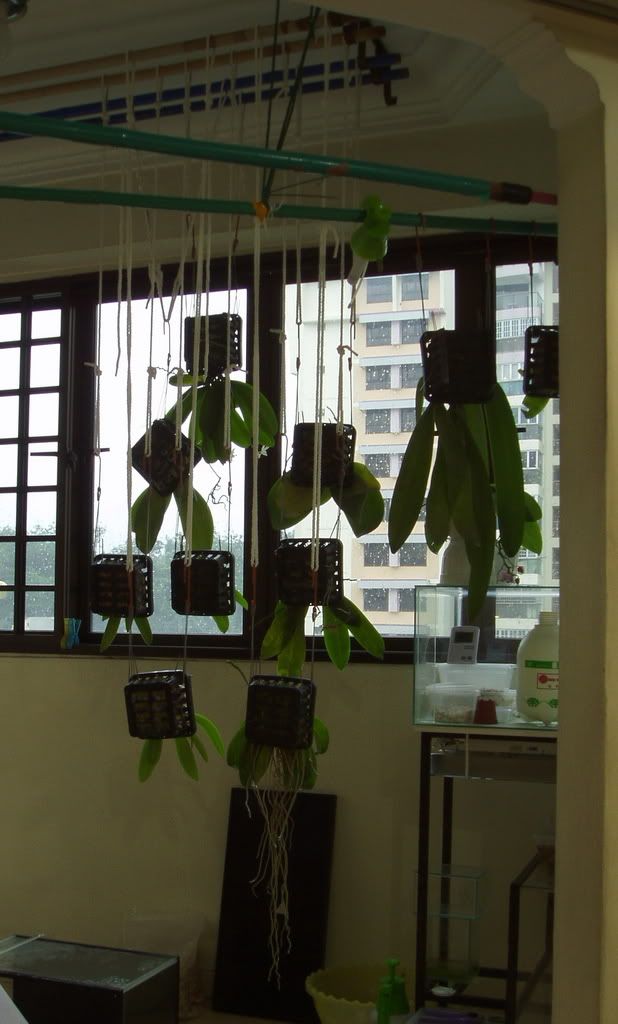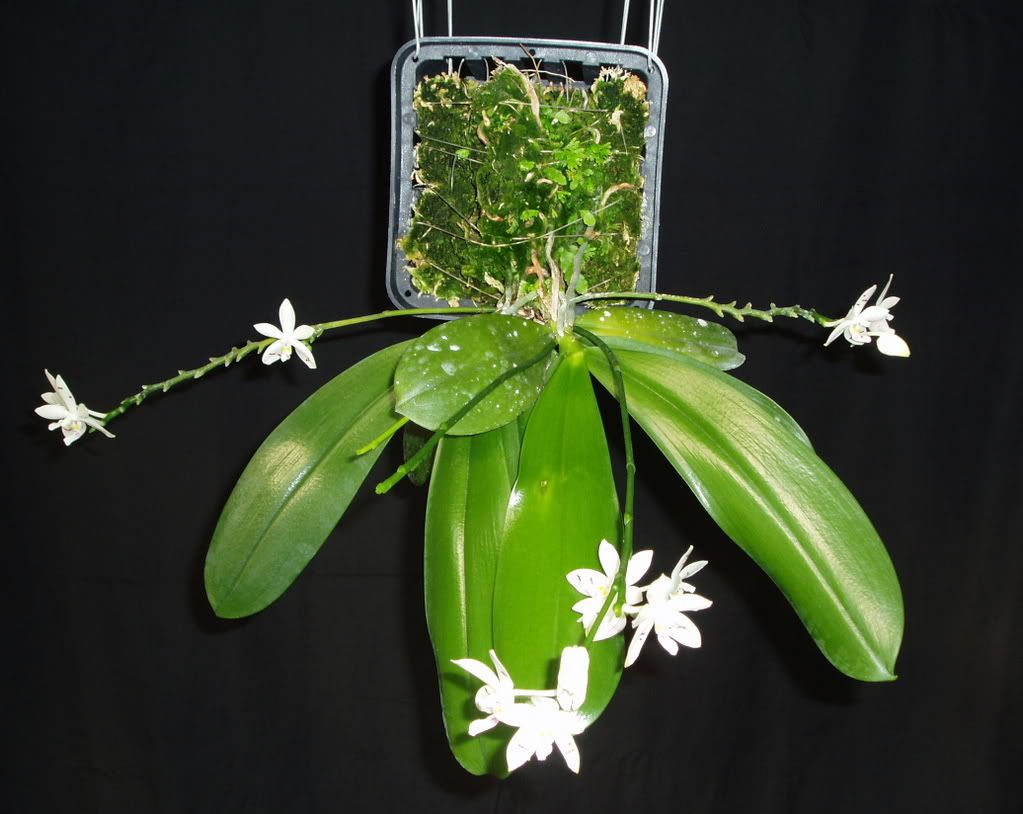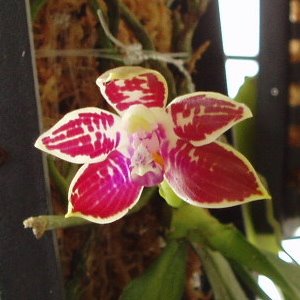Phalaenopsis growers over the world engage in many different growing techniques and cultures for their beloved plants. For instance, some growers cultivate Phalaenopsis by mounting them on fern bark or wood slabs with daily watering, while others pot them up with media where the plants are watered only when the media is dry. In return for having the right culture is an enjoyable hobby that stems from healthy, vigorous plants and magnificent displays of blooms. Choosing a suitable growing technique and culture for your Phalaenopsis orchids is easy, but it does require some simple research, understanding, evaluating, experimenting and learning.
In this article, I will explain how my Phalaenopsis plants are currently grown and how some present factors and constrains play important roles in making these cultivation decisions.
Personally, there are four main factors that determine how my plants are now grown: 1) the species or hybrids of Phalaenopsis grown, 2) the growing environment, 3) the growing technique and 4) the culture given. All the four aspects are such highly interdependent and delicately balanced that altering any one aspect will require changes in the other three aspects as well. Besides the factors mentioned above, there are also other constrains such as money, time and space that will eventually limit how far I can explore this hobby. If there were more than one suitable growing techniques or cultures after considering all the factors and constrains, the decision will naturally be made according to my preference.
The four factors
Now, I shall evaluate the four factors mentioned above.
1) Phalaenopsis plants grown
P. corningiana, P. cornu-cervi, P. equestris, P. gigantea, P. javanica, P. tetraspis, P. Violacea, P. violacea x Sogo Tris
2) Growing environment
Only a small corner of a very small balcony is allocated to me for gardening. It receives direct morning sun from about 7.30am to11.30am and bright light from sunlight reflected off the opposite building for the rest of the day. Late morning sunlight can be scorching hot on clear days. As the balcony partially faces open forested areas, winds can be very strong and destructive especially during the Northeast Monsoon periods. Rain often splashes into the balcony due to these winds and the design of the building. Thus, the tinted windows remain closed all the time to shelter the plants from these harsh weather elements. Side effects from the closed windows include high temperatures that can soar to 34.5oC in the late mornings due to the strong morning sun and extremely poor air circulations.

 Above: The growing area
Above: The growing area
3) Growing technique
My Phalaenopsis plants grown are suitable for both basket and pot cultures described below:
Basket culture: P. corningiana, P. cornu-cervi, P. equestris, P. gigantea, P. javanica, P. tetraspis, P. Violacea
Pot Culture: P. cornu-cervi, P. gigantea, P. violacea x Sogo Tris

Above: This Phal tetraspis performs very well mounted on a basket.
.

Above: The constant moisture provided by the pot, diatomite and sphagnum moss combination does the trick in blooming this Phal violacea x Sogo Tris well.
Baskets and pots carry media that can retain moisture, so watering can be done less frequently and this minimises water usage and saves time for other gardening activities. The weight of the baskets and pots filled with media gives them the stability needed against strong winds, especially during the monsoon periods where powerful busts of wind can create havoc even if majority of the windows were closed. Moreover, due to the manner in which they are hung, even the slightest wind can cause them to swing. Thus, stability for the hanging baskets is very important.
For basket culture, the media for most species comprises sphagnum moss lining the sides of the basket and diatomite filling the centre of the basket. For pot cultures, the media for plants other than P. cornu-cervi comprises mostly diatomite and a thin top layer of sphagnum moss above the diatomite.
Sphagnum moss retains moisture from watering while diatomite improves drainage and ensures just the right amount of water is retained in the media. The moisture holding ability of the moss eliminates the need for frequent watering thus minimises water usage and saves time for other gardening activities. The diatomite ensures that the media will not be soggy wet or remain wet for longer than what the plants are comfortable with. Furthermore, diatomite increases air circulation to the roots which is important in lowering the risk of root rots in a water retentive medium.
Another advantage of combining moss and diatomite as the media is that the proportions of the sphagnum moss and diatomite can be varied according to the plants’ requirements. Hence, the proportions of moss and diatomite in the baskets will be slightly different for different plants. More moss and less diatomite is used in the media for plants that love moisture and can withstand perpetual moisture at their roots as compared to that for plants preferring slight drying out between watering. This way, watering can be made easy by having the same watering regime for all plants and yet fulfilling the plants’ requirement for moisture; moisture-loving plants will still have moisture at their roots while others will not by the next watering.
.

.
Above: The baskets are hung up with hangers and ropes.
.

Above: The ropes are hung from the bamboo poles held by pole holders attached to the ceiling.
The baskets are hung up using hangers and ropes on bamboo poles that are held by pole holders attached to the ceiling. Suspending the baskets in mid-air eliminates the need for a common contact surface such as a big metal mesh to which the plants are hung. Together with the fact that no plants are touching one another, this suspension method prevents non-flying pests from crawling and spreading from basket to basket. All these form part and parcel of the pest control measures.
.

Above: The baskets are hung in a cascading manner.
Hanging the baskets in a cascading manner maximises the small space for gardening as it utilizes the length, breadth and height of the space. Not as many plants can be grown in that same space if they are arranged vertically on a vertical support or horizontally on the table. Furthermore, cascading the baskets reduces the chances of water droplets or pests falling from the plants above to those at the bottom. This lowers the chances of leaf rots and the spread of pests and diseases from the plants above to those at the bottom. Water droplets on leaves are best avoided as the poor air movement in the balcony increases the chances of rots.
In the array of plants, they are positioned as optimally as possible according to their light requirements. Plants that need protection from the scorching sun will either be placed at the top rank or get shaded by other plants above them when the late morning sunlight becomes strong. On the other hand, plants that can withstand the strong sunlight are unobstructed.
4) Culture
Watering:
The plants are watered once every two to three days if the weather is dry or every four to five days if it is wet. Different species with slightly different moisture requirements can be given the same watering regime as the proportions of moss and diatomite in the media are varied accordingly. To prevent root burns from salt build-ups in the media, the media are flushed through with water weekly. Similarly, leaf burns are prevented by spraying the leaves thoroughly with water monthly to wash off dirt and fertilizer salts on them.
Instead of mass watering, the plants are unhooked from their growing space and watered individually away from the rest of the plants. This avoids creating a mess in the balcony and lowers the risk of spreading pests and diseases between the plants. Water droplets on the leaves are blown dry by an electric fan after every watering, as poor air circulation in the balcony causes water to stay on the leave for longer periods and increases the possibility of rots.
Fertilizing:
Fertilizers are dissolved about half the recommended strength and applied to the media once a week.
Light:
They receive about 50% sunlight filtered through the tinted window panels in the morning and 50% reflected sunlight off the opposite building filtered through the same tinted panels in the afternoon.
Pest control:
Pest control measures are always strictly observed for having a pest-free collection brings many benefits. The biggest benefit is that there is no need to spray toxic pesticides that can be harmful to my family members especially when the plants are grown in the house. Having a pest-free collection enables me to enjoy this hobby without the constant battle with the pests or the worries over declining plant health as a result of these pests. Furthermore, monetary and time resources can be saved as there is no need to buy and spray chemicals.
.

Above: New plants are quarantined in one corner of the balcony (top left) away from the main collection of plants where they will be observed for signs of pests.
Concluding
Gardening is a dynamic, on-going process where improvements to existing theories and practices as well as new discoveries and knowledge are constantly being made. Growing Phalaenopsis is no exception and this present growing methodology described above may become obsolete very soon as I continue in my search for a better one.
